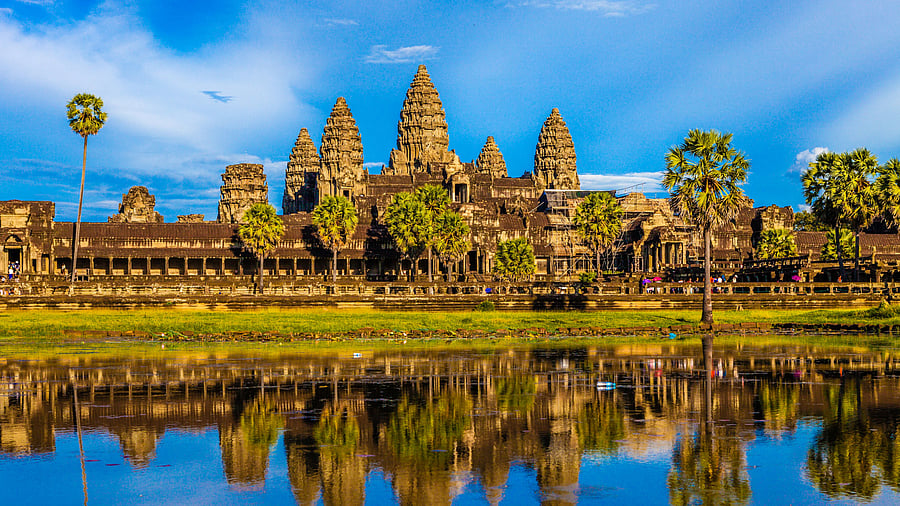
Credit: Special Arrangement
When I landed in Siem Reap, a quiet city in northwestern Cambodia, I had no idea what was in store. After a long flight from Bengaluru, India, all I wanted was a few hours of sleep. However, the scenic drive to the hotel, with fruit-laden trees alongside the well-maintained asphalt roads, was a refreshing change for a Bengalurean like me. During the course of our four-day stay, Siem Reap revealed many more sights, sounds, smells and fascinating stories.
Tryst with the locals
We spent much of our time cruising down the streets of Siem Reap in a rickety tuk tuk, listening intently to Lam, the driver we hired, who regaled us with stories from his past. A soldier-turned-tuk-tuk driver, Lam ferries tourists around, giving them the chance to experience Siem Reap intimately. He sleeps in his tuk tuk and rejoices when the monsoon rains wash the city clean. When heavy showers greeted us on our first day there, Lam generously offered us his two umbrellas for the duration of our stay.
Later, he took us to a local restaurant to try a classic Khmer dish called Amok, a creamy coconut curry scented with lemongrass, and paired with a meat, usually fish. Served in banana leaf bowls with a helping of rice, Amok became a staple on our trip. The Khmer cooking class was a special experience arranged at our hotel and started with a visit to the local market. The buzzy marketplace was a sight to see, selling everything from exotic fruits and fresh meat to children’s toys. Set up inside a large tent, it felt like a different world with people bustling around and the low hum of conversation in the air. This market had a unique charm to it and was a sharp contrast to the quiet streets.
Back at the kitchen, we donned our aprons and chef hats, and got to work by assembling a platter of fillings for our spring rolls with the hotel’s sous chef guiding us through every step.
As someone with little cooking experience, I found the class both challenging and enjoyable. On the menu: crispy vegetable spring rolls, fragrant fish amok and steamed rice. For dessert, we prepared a creamy banana sago pudding. The chef patiently demonstrated each step, encouraging us to smell, taste and ask questions about the dishes we were preparing. The immersive, hands-on class gave us a taste of Khmer cuisine and the meal felt well-earned.
Angkor Wat: If walls could talk
Of course, no visit to Siem Reap is complete without visiting its star attraction, Angkor Wat, a UNESCO World Heritage site.
Angkor Wat (City Temple) gained prominence in the 12th century as a place of worship. Legend has it that thousands of elephants were used to transport stones from the Kulen mountains, situated around 50 km away, to build Angkor Wat. Constructed on 400 acres of greenery, the religious site took around 30 years to complete.
Next, it was time for some performance art. Watching Siem Reap’s Phare (‘brightness of the arts’) circus was an unforgettable experience. Despite lacking the pomp and show of a traditional circus, audiences were left enthralled by a troupe of about 15 talented performers. From swinging on seemingly flimsy ropes launching themselves into the air in a series of graceful somersaults, this 90-minute performance kept me at the edge of my seat.
The Mi Phare acrobats are graduates from the Phare Ponleu Selpak School, an arts performance centre that promotes careers in circus performance. The school nurtures arts appreciation and gives underprivileged children employment opportunities in this unique field.
A dark history
While Cambodia boasts rich greenery, grand monuments, delectable food and culture, the country’s history is overshadowed by a darker past. A mass genocide in the late 70s by the oppressive communist Khmer Rouge regime, led by the dictator, Pol Pot, took the country to the brink of collapse and led to the death of nearly two million locals. What began as a radical dream to erase class distinctions and establish an agrarian economy escalated into one of the most
devastating massacres of the 20th century. Despite oppression and displacement, the people of Cambodia are resilient beyond measure.
The tourism industry is seasonal and therefore quite volatile, but thousands of Cambodians depend on it as their main source of income. In the face of unpredictability, people show a sense of pride in their work, coupled with a fierce determination to share their rich culture and heritage.
From its ancient temples to its vibrant culture, a visit to Siem Reap is more than just a relaxing getaway — it also brings a much-needed shift in perspective.
The ability of the Cambodians to pick themselves up and persevere through the toughest of conditions stands out. I left Siem Reap with more than souvenirs, and took with me stories of resilience, generosity, and a belly full of warm and comforting Amok.